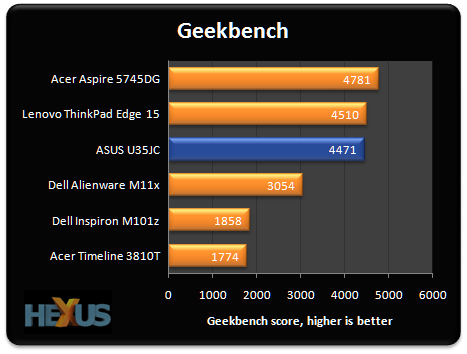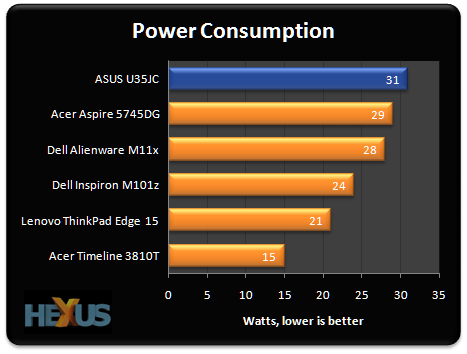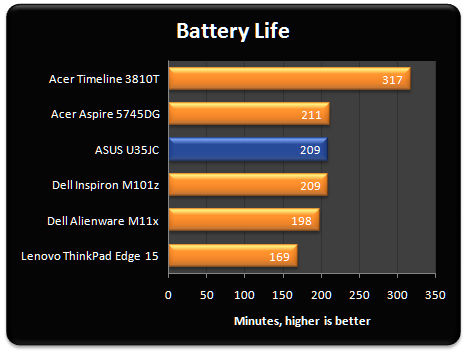Performance
ASUS's U35JC sums up what's good about 13.3in notebooks - they're light, ultra-thin, quiet and cool - but does it enhance performance while retaining the battery life we've come to expect from Intel's ultra-thin platform?
To find out exactly how it fares, we're pitting it against a previous-generation 13.3in Acer Timeline 3810T notebook equipped with a Core 2 Duo processor and Intel GMA 4500MHD graphics.
Still not sure if 13.3in is the right size for you? We're also including numbers from a couple of 11.6in notebooks and a couple of larger 15.6in models, too.
Here's a detailed look at the key specifications of our comparison notebooks, as well as a brief rundown of the benchmarks we use.
| Comparison systems | ||||||
|---|---|---|---|---|---|---|
| Laptop | Dell
Inspiron M101z |
Dell
Alienware M11x |
Acer Timeline 3810T | ASUS U35JC | Lenovo
ThinkPad Edge 15 |
Acer
Aspire 5745DG |
| Processor | AMD Athlon II Neo K325 (1.30GHz, 2MB L2 cache, dual-core) | Intel Core i5 520UM (1.06GHz, 3MB L3 cache, dual-core) | Intel Core 2 Duo SU9400 (1.40GHz, 3MB L2 cache, dual-core) | Intel Core i3 370M (2.4GHz, 3MB L3 cache, dual-core) | Intel Core i5 430M (2.26GHz, 3MB L3 cache, dual-core) | Intel Core i5 450M (2.4GHz, 3MB L3 cache, dual-core) |
| Memory | 4GB DDR3 | 4GB DDR3 | 2GB DDR3 | 4GB DDR3 | 4GB DDR3 | 4GB DDR3 |
| Graphics | AMD ATI Mobility Radeon HD 4225 | Intel HD Graphics + NVIDIA GeForce GT335M 1GB | Intel GMA 4500MHD | Intel HD Graphics + NVIDIA GeForce 310M 1GB | Intel HD Graphics | NVIDIA GeForce GT 425M 1GB |
| Graphics driver | AMD ATI Catalyst 10.7 | Intel 8.15.10.2182 + NVIDIA Verde 257.30 | Intel 7.15.10.1666 | Intel 8.15.10.2182 + NVIDIA Verde 258.96 | Intel 8.15.10.2057 | NVIDIA Verde 259.12 |
| Display | 11.6in - 1,366x768 | 11.6in - 1,366x768 | 13.3in - 1,366x768 | 13.3in - 1,366x768 | 15.6in - 1,366x768 | 15.6in - 1,366x768 |
| Battery | 6 cell, 56Whr | 6 cell, 63Whr | 6 cell, 56Whr | 8 cell, 84Whr | 6 cell, 48Whr | 12 cell, 99Whr |
| Weight | 1,572g (including battery) | 2,010g (including battery) | 1,645g (including battery) | 1,816g (including battery) | 2,476g (including battery) | 2,839g (including battery) |
| Wireless | Broadcom WLAN (802.11bgn) and Bluetooth 2.1 | Dell DW1520 (802.11bgn) and Bluetooth 2.1 | Intel WiFi 5100 (802.11bgn) and Bluetooth 2.0 | Atheros AR9285 (802.11bgn) and Bluetooth 2.1 | Intel WiFi Link 1000 (802.11bgn) and Bluetooth 2.1 | Broadcom WLAN (802.11bgn) and Bluetooth 3.0 |
| Disk drive | Seagate Momentus 320GB HDD, 7,200RPM, 16MB cache | Samsung 256GB PM800 SSD | Hitachi 500GB HDD, 5,400RPM, 8MB cache | Seagate Momentus 320GB HDD, 5,400RPM, 8MB cache | Seagate Momentus 320GB HDD, 5,400RPM, 8MB cache | Hitachi Travelstar 500GB HDD, 5,400RPM, 8MB cache |
| Optical drive | None | None | None | None | DVD-RW | Blu-ray/DVD RW combo |
| Operating System | Microsoft Windows 7 Home Premium, 64-bit | Microsoft Windows 7 Home Premium, 64-bit | Microsoft Windows 7 Home Premium, 32-bit | Microsoft Windows 7 Home Premium, 64-bit | Microsoft Windows 7 Professional, 64-bit | Microsoft Windows 7 Home Premium, 64-bit |
| Price | £499 | £949 |
£499 |
£670 | £705 |
£999 |
| Benchmarks | ||||||
| Geekbench 2.1.6 | A cross-platform benchmark used to measure memory and processor performance. Run using high-performance mode. | |||||
| Cinebench 11.5 | Using Cinebench's multi-CPU render, this cross-platform benchmark stresses as many cores as possible. Run using high-performance mode. | |||||
| 3DMark06 | A PC benchmark used to test the DirectX 9 performance of a system's graphics card. Run using high-performance mode. | |||||
| Battery test | In order to measure battery life, we run the notebook on balanced power settings and loop a 720p movie trailer, measuring the time taken to hibernate. | |||||
| Power consumption | Using balanced power settings, we record mains power draw whilst playing back a 720p movie trailer. | |||||
CPU and GPU performance

We're off to a flier. The 13.3in ASUS U35JC is almost on par with the two 15in notebooks in the Geekbench test.

Opting for a full-fat Core i3 processor certainly makes sense when it comes to out-and-out speed.
Compared to the ultra-low-voltage Core 2 Duo found in the Acer Timeline 3810T, The Core i3 chip used by ASUS's U35JC offers well over double the CPU performance. So long, last generation.

There's a sizable boost in GPU performance, too.
With the NVIDIA GeForce 310M on hand when needed, the U35JC is able to make light work of high-def multimedia. You'll have no trouble powering a full-HD display via the HDMI output, and the NVIDIA GPU of course has the benefit of CUDA acceleration in select applications.
3D gaming, too, isn't outside the realms of possibility. The GeForce GPU will struggle with today's most-demanding titles, but we were able to manage a modest average frame rate of 38.3 frames per second whilst playing Call of Duty: Modern Warfare 2 with ultra-low settings.
Battery life and power consumption

Performance is strong, but the ASUS U35JC isn't the most efficient notebook we've ever seen, eating up 31W of juice whilst playing back a 720p movie.

But that high-capacity eight-cell battery works wonders, with the notebook managing to playback our high-def video repeatedly for almost three and a half hours.
Not a bad return, and battery life is excellent when the NVIDIA GPU isn't continuously called into action. With the notebook switched to power-saver mode, we were able to keep going for just under eight hours of light use.
NVIDIA Optimus technology - which ensures the discrete GPU is enabled seamlessly only when required - certainly makes a lot of sense. The end result is a well-balanced combination of performance and battery life.









